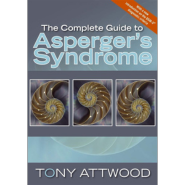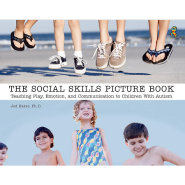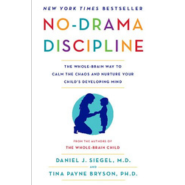20 Books on Autism and ASD Every Expert (and Parent) Should Read

Find your perfect college degree
In this article, we will be covering...
Autism Spectrum Disorder (ASD), a complex neurological and developmental disorder, affects about 1 in 36 children in the United States (CDC, 2020). With such prevalence, understanding and supporting affected individuals are a must for parents, educators, and therapists, particularly in promoting awareness and research into the disorder.
Fortunately, current literature on ASD and autism isn’t just diverse and extensive – it’s also continually changing. Parents and professionals must then stay informed about new research, knowledge, and insights that influence, even change, the way we think about ASD and autism.
Working with Autistic Individuals
Choosing a career that involves helping kids with autism can be a fulfilling and impactful decision. With the increasing prevalence of autism, there is a great need for professionals trained in this field who can provide support and intervention for children with autism.
Pursuing a degree program in fields such as special education, applied behavior analysis, speech-language pathology, can provide the necessary skills and knowledge to work with this population.
The cost of these degree programs can be a barrier for many students. Fortunately, there are financial scholarships available specifically for students pursuing degrees related to helping kids with autism. These scholarships not only alleviate the financial burden but also recognize the importance and value of this career path.
By receiving a scholarship, students can focus on their education and training, ultimately leading to a brighter future for children with autism.
Additional Resources:
- Best Grad Schools with Online Doctorate in Special Education
- College Scholarships for Students with Autism
- The Best Careers for People with Autism
- Autism Apps That Help People with ASD
In our curated list of the must-read 20 books on ASD and autism, we strive to provide our readers with diverse perspectives about the disorder. We then included books written by individuals with ASD and autism and their parents and by professionals with extensive experience in the field.
The result: Books that offer inspirational personal stories, practical intervention strategies for parents and professionals, and up-to-date information research into the disorder.
Thinking in Pictures – My Life with Autism
by Temple Grandin
Temple Grandin is undoubtedly the poster child, so to speak, for autism and is recognized for her pivotal role in championing neurodiversity movements and autism rights. Her seminal work on autism, Thinking in Pictures: My Life with Autism, is an insightful memoir that contains her personal experiences with the condition.
Her memoir is considered among the best readings for autism because it also provides practical strategies for people with ASD and their parents and caregivers.
The book contains several sections with clear-cut chapters that offer readers insights into her journey with autism and the ways that it has affected her life. Of particular interest for readers is Grandin’s thought processes that, as the title implies, involve thinking in pictures.
Basically, she’s a visual thinker who uses her sensory experiences in dealing with the challenges that come with autism in general and her work as an animal behaviorist in particular.
Grandin also discusses the trials and triumphs in her journey with autism, and her experiences are easily relatable for children and adults with the condition, too. Her engaging, inspiring, and clear writing style makes her book accessible to diverse readers, while her triumphs, both on the personal and professional levels, are truly an inspiration.
More importantly, her stern warning about seeking the silver bullet for autism should be heeded! Grandin recommends instead combining different approaches that work for an individual with autism.
Complete Guide to Asperger’s Syndrome
by Tony Attwood

Dr. Tony Attwood, a respected clinical psychologist known for his extensive work on Asperger’s syndrome and autism, continues to gain widespread recognition for his definitive work on these conditions. Parents and professionals alike attest to the comprehensive coverage that Dr. Attwood provides on these topics in this book.
The chapters are organized into clear and compelling topics that readers will find easy to understand, thanks to their logical progression. These include the causes and indications of Asperger’s syndrome, the diagnosis and its impact on both the individual and their parents, and the effect of Asperger’s syndrome on the sensory sensitivity, cognitive and language abilities, and movement and coordination skills among affected individuals.
Mental health issues caused by teasing, bullying, and perception of self are also discussed in depth.
Dr. Attwood also offers practical strategies for affected individuals and their parents and therapists in the effective management of their symptoms and the improvement of their quality of life. Inspirational personal stories, objective case studies, and research findings and development make the book suitable for a wide range of readers, too.
Check out the appendices for more information about available resources and tools in the condition.
The Asperger’s Children’s Toolkit
by Francis Musgrave
Francis Musgrave, the founder and former trustee of AS Active, wrote and illustrated The Asperger’s Children’s Toolkit with originality, creativity and interactivity in mind. The likable characters in his colorfully illustrated book, such as the Social Scientist, the Sensory Detective, and the Brain Guru, provide readers with practical advice about the challenges that children with Asperger’s deal with daily.
There are general strategies and specific tips about dealing with sensory overload, anxiety and social situations, even about handling friendships and family relationships.
The pieces of practical advice are embedded in workable activities and cut-and-keep tools that both children and adults with Asperger’s can use. This is among the reasons for its widely recognized features of originality, creativity, and interactivity, as well as an emphasis on the use of positive reinforcement and the focus on positive behavior in building success one activity at a time.
There are no dos and don’ts here, and neither a high-horse, preachy approach toward adults affected by Asperger’s nor a condescending tone toward children with the condition.
Plus, we like that it emphasizes fun activities! Dealing with Asperger’s shouldn’t be burdensome, after all, when uncomfortable experiences can be turned into positive things.
The Loving Push – How Parents & Professionals Can Help Spectrum Kids Become Successful Adults
by Debra Moore and Temple Grandin

With the personal experiences of Temple Grandin, who’s considered a high-functioning, high-achieving individual with autism, and the professional experience of Debra Moore, a clinical psychologist combined, The Loving Push is a must-read for parents, caregivers, and professionals alike.
The book focuses on the transition from childhood to adulthood among individuals with ASD and autism, as well as provides insightful guidance and practical support during each step of the transition period.
The comprehensive coverage makes it a relatively long read, but it’s something that committed parents will appreciate, considering the great unknown and pervasive uncertainty that often comes with living with ASD and autism. The childhood-to-adulthood transition covers a wide range of topics, from building life skills vital for independence to fostering positive personal relationships and professional success.
The strategies discussed in the book are, indeed, relatable and achievable because Grandin herself is living proof of their effectiveness! There are several real-life scenarios that adults with autism can relate to and gain insights and inspiration from, and these can be tweaked depending on their unique circumstances.
Grandin also emphasizes that learned helplessness and negative thinking can be overcome, which is a vital skill in learning domestic skills, working for a living, and being part of a community.
The Autism Discussion Page on the Core Challenges of Autism (A Toolbox for Helping Children with Autism Feel Safe, Accepted & Competent)
by Bill Nason
Children with autism struggle with social interactions that make them feel less safe and accepted by their family and friends. Bill Nason’s The Autism Discussion Page provides readers with concise yet comprehensive information, simple yet effective tools, and useful insights vital in making children with autism feel safe, accepted, and competent.
The neurotypical readers, including parents, teachers, and professionals, will find easy-to-understand explanations of what it feels like to deal with autism. For example, the discussions on the sensory aspects and the effective ways of self-regulation are useful for parents and children concerned with the impact of anxiety attacks.
Nason’s ability to present autism-related information and the ways of understanding and supporting individuals with the condition – clear, concise,, and compassionate while still maintaining a professional tone – is gold in itself, too.
We also love the logical arrangement of the chapters, such as Acceptance and Understanding, Cognitive Issues in Autism, and The Emotional World on the Spectrum.
The Reason I Jump: Inner Voice of a Thirteen-Year-Old Boy with Autism
by Naoki Higashida

When Naoki Higashida wrote The Reason I Jump, he was just a 13-year-old boy struggling with autism. This is his autobiography, a book that gives readers a remarkable view into the mind of a teenager whose perspectives and experiences are like a square peg in a round hole. But he doesn’t ask for sympathy, much less pity – only for understanding and acceptance of the uniqueness with which individuals with autism see the world.
Such is the heartfelt writing combined with useful insights that Higashida uses that his book has been translated into several languages; David Mitchell translated the English version. This is a short book, but there’s a purpose in every word; although the core message itself may be repetitive, it’s also in the repetition that Higashida succeeds in reaching a wider audience.
Several personal anecdotes highlight the mimicry behaviors that children with autism – the goodbye wave is a great example – adopt in their everyday lives, frequently to the bewilderment of neurotypical individuals.
These mimicry behaviors not only result in socially awkward situations but also highlight the misconceptions that both neurotypical and neurodiverse individuals are subject to.
Autism Breakthrough – The Groundbreaking Method That Has Helped Families All Over the World
by Raun K. Kaufman
When he was diagnosed with severe autism at two years old, Raun Kaufman wasn’t committed to an institution, as was recommended then. Instead, his parents developed the Son-Rise Program that enabled him to overcome the challenges of severe autism and become a successful adult. His journey is remarkable, too, considering that he was a non-verbal child before his parents’ intervention!
He introduces the Son-Rise Program through his book, Autism Breakthrough, and inspires families dealing with autism that, indeed, there’s hope. The Son-Rise Program emphasizes the use of intensive one-on-one interactions, building meaningful emotional connections, and adopting unconditional love for children with autism.
Parents, caregivers, and professionals play crucial roles in nurturing progress among children with autism, and these roles encompass the mental, emotional, and social aspects.
Kaufman’s book is highly recommended because of its first-hand perspective and his inspiring story. Beware, nonetheless, that the Son-Rise program isn’t exactly aligned with the mainstream approach toward autism – its strategies have been labeled controversial and unconventional.
But therein also lies one of its strengths – if you’re willing to look at alternative strategies for your child, then it’s a good reference.
NeuroTribes: The Legacy of Autism & the Future of Neurodiversity
by Steve Silberman

In the neurodiverse world of autism-specific books, Silberman is an oddity himself! He’s neither an individual with autism nor a parent or professional dealing with autism on a daily basis. Instead, he’s a well-respected journalist in technology and the digital industry, with his first autism-related article published in 2001 (The Geek Syndrome).
But his work in Neurotribes is considered a must-read, too, among people with autism and parents and professionals involved because of its comprehensive coverage of autism’s nature.
Published in 2015, Neurotribes explores the evolution of our contemporary understanding of autism, from its first definition in 1943 as a rare childhood disorder to its current pervasiveness (i.e., one in 68 persons in the United States).
Silberman’s gift for the compelling narrative complements his objective journalist’s perspective, a combination that results in an informative, engaging and insightful read. His talent for combining diverse perspectives is particularly evident in the diverse opinions that divide parents, advocates and professionals, and persons with autism.
Silberman presents several compelling portrayals of persons with autism and their families that aim to celebrate them, not exclude them from the mainstream societal narrative. He also challenges the preconceived notions of autism and the traditional approaches to its management.
The Out-of-Sync Child: Recognizing & Coping with Sensory Processing Disorder
by Carol Kranowitz
With her 25-year teaching experience, Carol Kranowitz writes The Out-of-Sync Child with useful information and strategies in mind. First published in 1998, it became the basis for the successful Sync series and succeeding editions.
This is particularly useful for parents, caregivers and teachers whose limited awareness of sensory processing difficulties makes them less able to successfully interact with and assist children with a sensory processing disorder.
There are two parts in the book – first, the characteristics of sensory processing disorder and their impact on everyday life, and second, options for effective interventions, including suggestions for coping in home and classroom situations.
Every part is divided into relevant chapters that make it easy for readers to build on their previous knowledge and gain better insights into the disorder. The book also includes other relevant references and resources that parents, teachers and professionals can use to improve their understanding.
Social Skills Picture Book – Teaching Communication, Play & Emotion
by Jed Baker

As Temple Grandin asserts, many persons with autism think in pictures – and that’s exactly what Jeb Baker and his The Social Skills Picture Book tap into! The iParenting Media Award winner uses photographs of people involved in a wide range of real-life social scenarios with right-and-wrong comparisons and positive-and-negative consequences clearly portrayed.
Note that while this is a child-appropriate book, parents, teachers and adults must facilitate the discussions related to the social situations portrayed. Children and adults can then engage in role-playing for a better understanding of the specific social situation, as well as for exploring their nuances and reasons.
We love that the instructional picture book covers several social skills, from making conversations to displaying empathy.
The author also ensures that children not only learn the basics of these social skills but also improve on them through follow-up steps. We even recommend it for parents with neurotypical children who want to understand and interact better with children with autism – children, after all, learn from each other.
Early Start for Your Child with Autism – Using Everyday Activities to Help Kids Connect, Communicate, & Learn
by Sally J. Rogers, Geraldine Dawson, Laurie A. Vismara
Even everyday activities can become learning experiences for children with autism! This is the core message of An Early Start for Your Child with Autism, an American Journal of Nursing Book of the Year awardee. Of course, parents and caregivers of children with autism have crucial roles in the personal, mental, and emotional growth of children with ASD.
Drs. Rogers, Dawson, and Vismara acknowledge the challenges that living with autism brings to affected children and their families. However, their comprehensive approach toward early diagnosis and interventions, practical strategies in turning daily routines into fun learning opportunities, and evidence-based guidance make overcoming these challenges easier.
Since children with autism struggle with social skills, the authors provide parents with clear and concise strategies for fostering their children’s social skills, including communication, play and language development.
Parents are also strongly encouraged to collaborate with educators and therapists so that their children can receive personalized attention in line with their autism-related management plan.
Uniquely Human: A Different Way of Seeing Autism
by Barry M. Prizant

With his 40-year experience as a researcher and clinician, Dr. Prizant can’t be blamed if he takes a clinical approach toward autism and the individuals affected by it. Instead, his book Uniquely Human is a breath of fresh air and breathtakingly simple in its approach!
Prizant advocates for the humanity of people with autism and their ability to live their best lives. Instead of looking at autism as a checklist of deficiencies, we should aid them in the development of their abilities that enable them to take control over their lives.
There’s no thrust toward fixing the child, making them comply with neurotypical behaviors, and eliminating the typical signs of autism (e.g., random word repetition, spinning in place, and hand flapping).
In other words, autism is a “different way of being human” – it’s neither an illness nor a disorder! With such a mindset, parents, teachers, and therapists can establish and maintain more meaningful connections with children and adults with autism.
The result: Better communication and collaboration that maximizes their potential for improved quality of life.
The Autistic Brain – Thinking Across the Spectrum
by Richard Panek and Temple Grandin
The book partnership between Grandin and Panek makes The Autistic Brain an engaging and informative read, too, thanks to their different yet complementary writing styles and personal perspectives. While Grandin provides profound insights based on her personal experiences with autism, Panek provides compelling narratives that contribute to a better understanding of the condition.
The Autistic Brain dives deeper into the complexities of the brain among persons with autism, as well as discusses the latest research into brain structure and physiology, sensory perception, and genetics in the field.
Like Prizant and Silberman, the co-authors also emphasize that autism isn’t exclusively an illness or a disorder. Instead, their focus is on raising awareness that individuals with autism are just that – unique individuals in their own right – and on accepting the neurodiversity within them in particular and among humans in general.
There’s also a strong emphasis on considering environmental, contextual, and societal factors when understanding autism and the development of its symptoms. In doing so, individualistic interventions can be created that, hopefully, will be more effective.
No-Drama Discipline – The Whole-Brain Way to Calm the Chaos & Nurture Your Child’s Developing Mind
by Daniel J. Siegel and Tina Payne Bryson

The audiobook No-Drama Discipline offers practical strategies for parents, educators, and therapists in calming the chaos, so to speak, which can be a challenge even in the best of times. Children with autism have difficulty dealing with discipline that, in turn, exacerbates tantrums and tensions – and it can be an everyday occurrence that can push every parent and teacher to their limit.
Siegel and Bryson promote whole-brain parenting in the audiobook, an approach that emphasizes understanding child development in the context of brain development.
By understanding the science, parents, teachers, and therapists can create a discipline strategy best suited for every child – and no drama, fuss, or fast-and-furious words are involved either.
The co-authors provide a unique perspective on discipline through strategies based on psychology and neurobiology. Instead of punishment, parents and teachers are encouraged to connect and communicate with children and redirect their energy and emotions toward a positive direction.
By turning reactivity into receptivity, discipline becomes a positive influence on brain development and, thus, on child development. There are step-by-step guides, too, combined with effective strategies, such as getting to their eye level and validating their feelings, which parents and teachers can adopt.
The Autism Adulthood Workbook: Strategies and Insights for a Fulfilling Life
by Susan Senator
Nat, the Senator’s adult son, was diagnosed with autism as a young boy, so she speaks from personal experience. The Autism Adulthood Workbook is a combination guidebook and self-help book aimed at persons with autism and their families challenged by the childhood-to-adulthood transition.
Readers will benefit from the engaging activities and learning exercises in the workbook, as well as information about the organizations and websites that offer assistance.
There’s plenty of practical advice, inspirational anecdotes, and valuable insights in the book that make it an excellent resource. What’s more, Senator covers most of the big issues that adults with autism who want independence face in their everyday lives – employment, housing, personal and professional relationships, and finding competent caregivers, among others.
Her emphasis on self-advocacy makes her work even more crucial for adults with autism to go out into the world and find their place.
Thinking Person’s Guide to Autism
edited by Shannon Des Roches Rosa, Jennifer Byde Myers, and Liz Ditz

The diversity of experiences, opinions, and ideas regarding autism is as diverse as the persons diagnosed with it and their families. In the Thinking Person’s Guide to Autism, such diversity is celebrated in the short personal essays that cover a wide range of topics.
These include rights and advocacy, sensory issues and behavior management, and education and employment, as well as conventional and controversial therapies, meaning the content covers issues concerning both children and adults with autism.
The chapters are organized in systematic order, too, meaning readers can build on their knowledge with each succeeding chapter. Thus, there’s a chapter on the first steps after an autism diagnosis, followed by practical advice for parents, caregiving strategies, and therapies, among others.
After the collection of essays, there’s a section where more resources, such as books, blogs, and movies, for persons with autism and their parents, can be found.
We want to call attention to the crucial importance of the “Causation and Dubious Therapies” section, too. Parents must be particularly vigilant in using information related to suspicious therapies.
The Asperkid’s (Secret) Book of Social Rules – Handbook of Not-So-Obvious Social Guidelines for Tweens & Teens with Asperger Syndrome
by Jennifer Cook O’Toole
With middle school and high school-aged teens with autism as its main target audience, The Asperkid’s (Secret) Book of Social Rules offers practical information about the whys and hows of social conventions.
While there are a few questionable suggestions, such as children not questioning adults, the book is a highly recommended primer for tweens and teens who want to improve their social skills. Children and teens alike will also find that many, if not most, of the social situations and conventions they struggle with are covered in the book.
O’Toole herself knows what she’s talking about, as she has also been diagnosed with Asperger’s. She has been there and done that, but her language and tone in the book demonstrate her empathy, encouragement, and hope for better things ahead for tweens and teens.
We like the “Secret Rule” format, too, which combines informative advice and humor in a conversational style.
Ten Things Every Child with Autism Wishes You Knew
by Ellen Notbohm

Based on a November 2004 article, the book Ten Things Every Child with Autism Wishes You Knew was published in 2005, and it has become a must-read for persons with autism and their parents, teachers, and therapists.
Notbohm succeeds in raising wider awareness and advocacy for autism without being preachy about it, as well as in providing practical strategies that parents can adopt.
In brief, these ten things are:
- Behavior is communication in itself
- Never make assumptions about anything
- Consider possible sensory issues first
- Breaks are vital for self-regulation and should be granted even before I need it
- Tell me what you want positively and affirmatively instead of giving out orders
- Set reasonable expectations
- Provide a transition period between activities
- Avoid making bad situations even worse
- Use gentle criticism
- Offer reasonable and real choices
Are you intrigued? Then, you should check out the book! You will find plenty of practical tips for adopting these measures in it.

The Verbal Behavior Approach: How to Teach Children with Autism & Related Disorders
by Mary Lynch Barbera and Tracy Rasmussen
“It takes two to talk.” This is the underlying concept in the verbal behavior approach discussed in the book co-authored by Barbera and Rasmussen, and it’s aimed at both parents and professionals, such as speech-language pathologists.
The co-authors discuss the complex principles and practices behind the verbal behavior approach in a manner that makes them more understandable and applicable in daily life.
Note that the book mainly targets speech-language pathologists as its primary audience, meaning there may be jargon requiring more reading.
Nonetheless, it’s the kind of book that parents committed to their children’s growth in their communication skills will find useful. The chapters cover relevant topics in behavior and behavior modification, assessment strategies, and appropriate interventions.
Asperger’s Rules!: How to Make Sense of School and Friends
by Blythe Grossberg

Grossberg wrote Asperger’s Rules as a workbook that enables children with autism to understand the general unwritten rules of social interactions in school. Children and their parents benefit from the bulleted lists, dialogue trees, and fill-in-the-blank and multiple-choice activities dealing with common social scenarios.
There are also brief analyses, goal setting, and demonstrations of appropriate responses that children and parents can practice in role-playing situations.
We love that the pieces of advice Grossberg gives have a straightforward yet solid quality to them, meaning children and teens with autism can apply them in their daily lives. There’s more compassion in the discussions and less condescension in the articles, which makes the book such an excellent resource.
In conclusion, these 20 books offer an abundance of useful insights, practical advice, and informative resources that make living with autism, whether as a diagnosed individual, a parent, or an educator using art for therapy, more rewarding.
We must emphasize, however, that with the continuing research into autism and ASD, it’s of crucial importance to stay updated and maintain an open mind. In addition, there are many Autism apps that help people with ASD.




